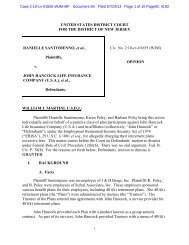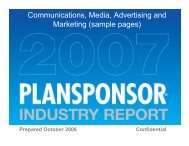Case: 2:10-cv-01160-ALM-TPK Doc #: 1 Filed: 12/22/10 Page: 1 of ...
Case: 2:10-cv-01160-ALM-TPK Doc #: 1 Filed: 12/22/10 Page: 1 of ...
Case: 2:10-cv-01160-ALM-TPK Doc #: 1 Filed: 12/22/10 Page: 1 of ...
Create successful ePaper yourself
Turn your PDF publications into a flip-book with our unique Google optimized e-Paper software.
<strong>Case</strong>: 2:<strong>10</strong>-<strong>cv</strong>-<strong>01160</strong>-<strong>ALM</strong>-<strong>TPK</strong> <strong>Doc</strong> #: 1 <strong>Filed</strong>: <strong>12</strong>/<strong>22</strong>/<strong>10</strong> <strong>Page</strong>: <strong>12</strong> <strong>of</strong> 36 PAGEID #: <strong>12</strong>38. SIVs make money by selling shorter term notes and using the proceeds topurchase medium and long-term assets because the longer term assets that are purchasedtypically pay a coupon rate that is higher than the interest rate on the shorter term notes.The riskier the longer term assets, the greater the pr<strong>of</strong>its that can be earned by an SIV.39. SIVs use operational triggers to automatically control risk and manageleverage. If pre-set triggers occur, the management <strong>of</strong> the SIV may be changed and/orthe activities <strong>of</strong> the SIV may be limited. Typically, the triggers are cash flow tests,portfolio restrictions and liability limits. Cash flow triggers can be set <strong>of</strong>f by insufficientcredit enhancement, interest rate and foreign exchange risks, insufficient liquidity andexcessive cash outflow. Portfolio restriction triggers are set <strong>of</strong>f when portfolio risktolerance boundaries are exceeded.Finally, an improper mix <strong>of</strong> liabilities sets <strong>of</strong>fliability restriction triggers.40. Depending on the particular triggers that are tripped, the fund managermay be changed, restrictions may be placed on the issuance <strong>of</strong> debt and payment <strong>of</strong> debt,and restrictions may be placed on the investments that could be made by the SIV. In thenormal operational state, the SIV manager is in charge <strong>of</strong> portfolio management and theSIV is free to pursue investments and issue MTNs and commercial paper. However, ifcertain operational triggers are tripped, the SIV moves into a restricted operational statein which new investments and payment on subordinate capital notes is prohibited. Iffurther triggers occur the SIV is restricted from issuing debt, existing assets can only beexchanged for cash and only senior debt holders can be paid.Finally, upon theoccurrence <strong>of</strong> the final set <strong>of</strong> triggers, a receiver is put in charge <strong>of</strong> portfolio managementand a wind-down <strong>of</strong> the SIV begins.<strong>12</strong>







